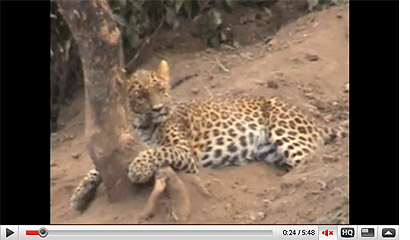
ROLE OF SOCIETY
Some lessons to be learnt from ~ http://www.youtube.com/watch?v=xVgLDibDAog
The video is a typical illustration of how most wild carnivore rescues are carried out in our country. Except for Kerala and Assam veterinary doctors have poor exposure to wildlife and tranquilising techniques. Although almost every nook and corner in India has Livestock Development Officers (veterinarians) they lack training in wild animal rescue and medicine. Nor is the Forest Department exposed to this aspect in their induction and training.
For instance in this video, the animal is writhing around trying to escape which also means the noose is getting tighter. It does not realise that the humans approaching with nets and sticks are actually trying to help! It is highly stressed which you can make out from its expression and the way it is breathing – and stress can adversely affects its health. Also since it is desperate it is likely to attack any person who comes nearby.
| Ideal scenario | ||
| 1 | A good police presence to keep people out of the animal’s sight | |
| 2 | Procure a trap cage and a veterinarian in the meanwhile | |
| 3 | A team of 3-4 forest department local staff arrive with blowpipe and tranquilisers | |
| 4 | Dart the animal from 10 m away, wait for 20 min for the effect of the drugs to take place | |
| 5 | Cut the snare and carry out basic veterinary treatment becuase later the animal would be out of anaesthesia and it would not be possible to treat it | |
| 6 | Put the animal in the trap cage | |
| 7 | Take it to a secluded forest department nursery in the nearby area (there are always forest rest houses and nurseries in all districts) | |
| 8 | Release it in the night in the nursery/rest house if there have been no attacks on people because obviously the animal was in its territory doing its own thing when it unfortunately walked into the snare | |
| Policy changes required | ||
| 1 | To start wildlife veterinary courses in veterinary colleges | |
| 2 | To get the rescue and rehabilitation NGO’s to be important partners in the above work | |
| 3 | To create a mechanism by which a dedicated rescue team of Forest staff is present in each district | |
| Please see | ||
| Athreya, V.R. & A.V. Belsare. 2005 Training Maharashtra Forest Department personnel to use chemical restraint and micro-chips to better manage man-leopard conflict. Report submitted to The Rufford Maurice Laing Foundation, U.K. | ||

